2018-2019-1 20189221《Linux内核原理与分析》第三周作业
2018-2019-1 20189221《Linux内核原理与分析》第三周作业
实验二 完成一个简单的时间片轮转多道程序内核代码
实验过程
在实验楼中编译内核
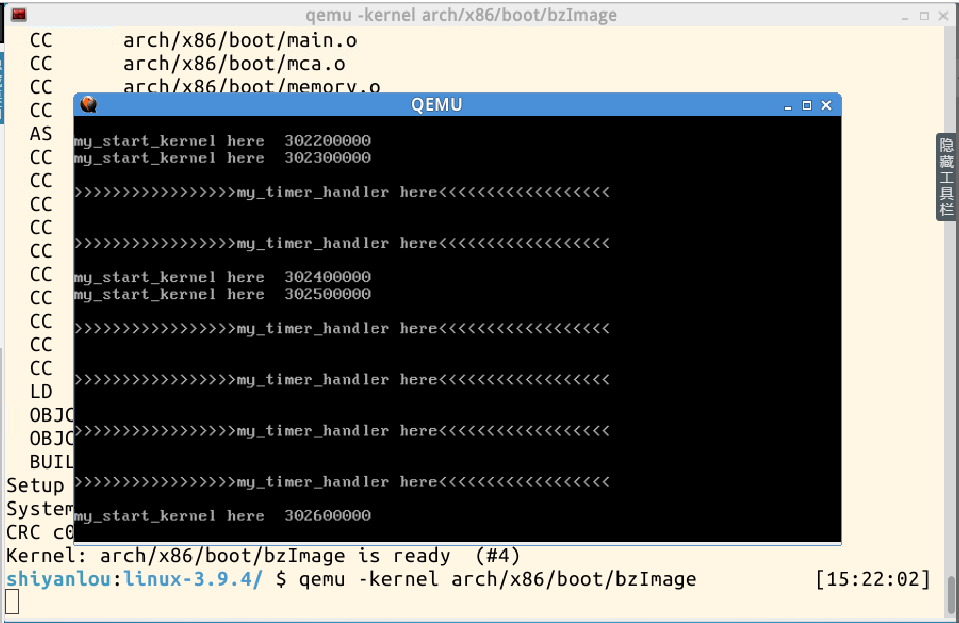
编写mymain.c函数和myinterrupt.c函数实现时间片轮转调用
mymain.c:
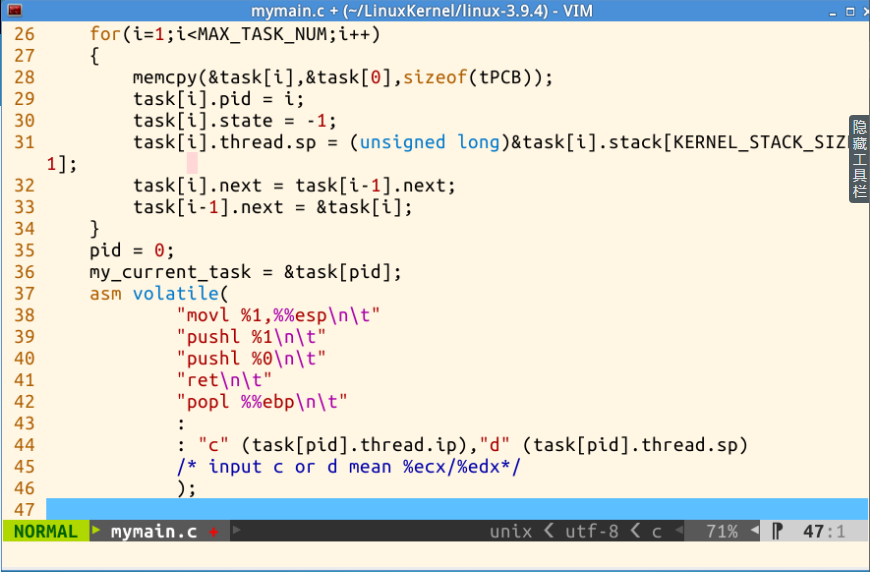
myinterrupt.c:
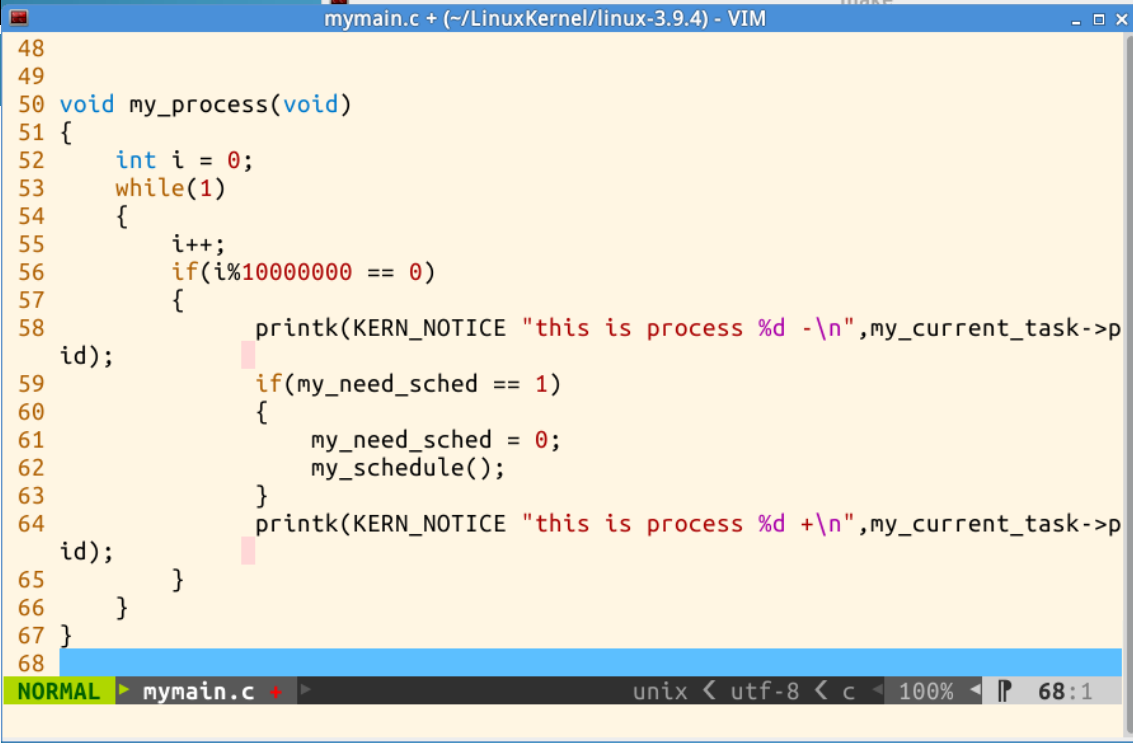
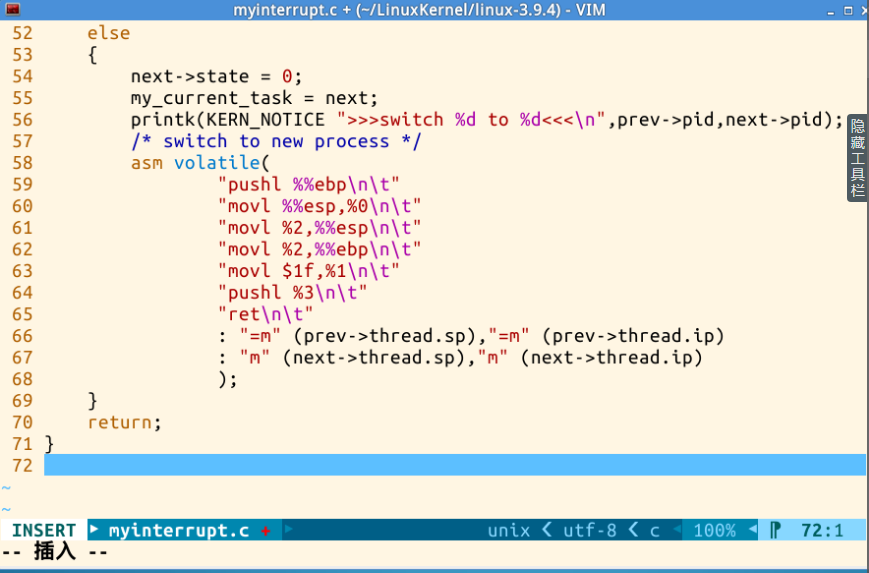
make:

内核实现:
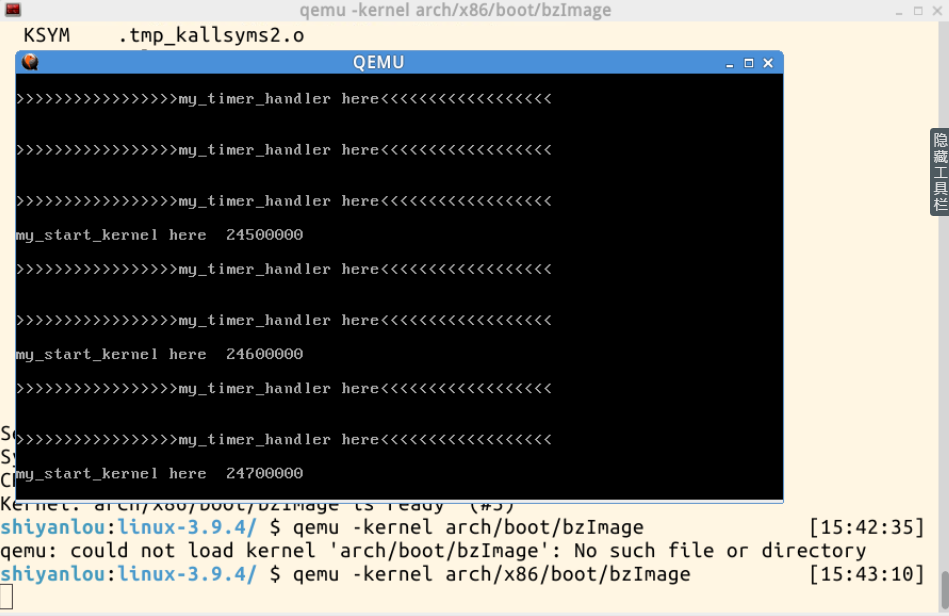
代码分析
代码使用的是《 庖丁解牛Linux内核分析》书中代码:
mypcb.h:定义了PCB结构体
#define MAX_TASK_NUM 4
#define KERNEL_STACK_SIZE 1024*8
struct Thread {
unsigned long ip
unsigned long sp
};
typedef struct PCB
int pid;
volatile long state; /* -1 unrunnable, 0 runnable, >0 stopped */
char stack[KERNEL_STACK_SIZE];
struct Thread thread;
unsigned long task_entry;
struct PCB *next;
}tPCB;
void my_schedule(void)
- ip用于eip的保存
- sp用于esp的保存
- pid--> 进程号
- state--> 进程状态
- stack[KERNEL_STACK_SIZE]--> 进程的栈
- Thread Thread--> Thread结构体
- task_entry--> 起始入口地址
- PCB *next-->next指针。
mymain.c:初始化进程,启功0号进程
#include <linux/types.h>
#include <linux/string.h>
#include <linux/ctype.h>
#include <linux/tty.h>
#include <linux/vmalloc.h>
#include "mypcb.h"
tPCB task[MAX_TASK_NUM];
tPCB * my_current_task = NULL;
volatile int my_need_sched = 0
void my_process(void);
void __init my_start_kernel(void)
{
int pid = 0
int i;
task[pid].pid = pid;
task[pid].state = 0;/* -1 unrunnable, 0 runnable, >0 stopped */
task[pid].task_entry = task[pid].thread.ip = (unsigned long)my_process;
task[pid].thread.sp = (unsigned long)&task[pid].stack[KERNEL_STACK_SIZE-1];
task[pid].next = &task[pid];
for(i=1;i<MAX_TASK_NUM;i++)
{
memcpy(&task[i],&task[0],sizeof(tPCB));
task[i].pid = i;
task[i].state = -1;
task[i].thread.sp = (unsigned long)&task[i].stack[KERNEL_STACK_SIZE-1];
task[i].next = task[i-1].next;
task[i-1].next = &task[i];
}
pid = 0;
my_current_task = &task[pid];
asm volatile(
"movl %1,%%esp\n\t"
"pushl %1\n\t"
"pushl %0\n\t"
"ret\n\t"
"popl %%ebp\n\t"
:
: "c" (task[pid].thread.ip),"d" (task[pid].thread.sp)
/* input c or d mean %ecx/%edx*/
);
}
void my_process(void)
{
int i = 0;
while(1)
{
i++;
if(i%10000000 == 0)
{
printk(KERN_NOTICE "this is process %d -\n",my_current_task->pid);
if(my_need_sched == 1)
{
my_need_sched = 0;
my_schedule();
}
printk(KERN_NOTICE "this is process %d +\n",my_current_task->pid);
}
}
}
- my_start_kernel作为标志,用来表示是否调度
- 创建的新进程放在进程列表尾部,所有的进程是一个循环链表
myinterrupt.c:产生中断,my_need_sched标志设1,
#include <linux/types.h>
#include <linux/string.h>
#include <linux/ctype.h>
#include <linux/tty.h>
#include <linux/vmalloc.h>
#include "mypcb.h"
extern tPCB task[MAX_TASK_NUM];
extern tPCB * my_current_task;
extern volatile int my_need_sched;
volatile int time_count = 0;
void my_timer_handler(void)
{
#if 1
if(time_count%10000 == 0 && my_need_sched != 1)
{
printk(KERN_NOTICE ">>>my_timer_handler here<<<\n");
my_need_sched = 1;
}
time_count ++ ;
#endif
return;
}
void my_schedule(void)
{
tPCB * next;
tPCB * prev;
if(my_current_task == NULL
|| my_current_task->next == NULL)
{
return;
}
printk(KERN_NOTICE ">>>my_schedule<<<\n");
/* schedule */
next = my_current_task->next;
prev = my_current_task;
if(next->state == 0)/* -1 unrunnable, 0 runnable, >0 stopped */
{
asm volatile(
"pushl %%ebp\n\t"
"movl %%esp,%0\n\t"
"movl %2,%%esp\n\t"
"movl $1f,%1\n\t"
"pushl %3\n\t"
"ret\n\t"
"1:\t"
"popl %%ebp\n\t"
: "=m" (prev->thread.sp),"=m" (prev->thread.ip)
: "m" (next->thread.sp),"m" (next->thread.ip)
);
my_current_task = next;
printk(KERN_NOTICE ">>>switch %d to %d<<<\n",prev->pid,next->pid);
}
else
{
next->state = 0;
my_current_task = next;
printk(KERN_NOTICE ">>>switch %d to %d<<<\n",prev->pid,next->pid);
/* switch to new process */
asm volatile(
"pushl %%ebp\n\t"
"movl %%esp,%0\n\t"
"movl %2,%%esp\n\t"
"movl %2,%%ebp\n\t"
"movl $1f,%1\n\t"
"pushl %3\n\t"
"ret\n\t"
: "=m" (prev->thread.sp),"=m" (prev->thread.ip)
: "m" (next->thread.sp),"m" (next->thread.ip)
);
}
return;
}
- if判断下一个进程是否可运行,执行进程切换
以myinterrupt.c中的asm内嵌汇编程序为例:
"pushl %%ebp" /* 保存当前ebp */
"movl %%esp,%0" /* 保存当前esp */
"movl %2,%%esp" /* 重新记录要跳转进程的esp,%2为 next->thread.sp*/
"movl $1f,%1" /* 保存当前eip ,%1为prev->thread.ip*/
"pushl %3"
"ret" /* 记录要跳转进程的eip,%3为 next->thread.ip*/
"1:\t" /* 下一个进程开始执行 */
"popl %%ebp"
: "=m" (prev->thread.sp),"=m" (prev->thread.ip)
: "m" (next->thread.sp),"m" (next->thread.ip)
堆栈调用过程:
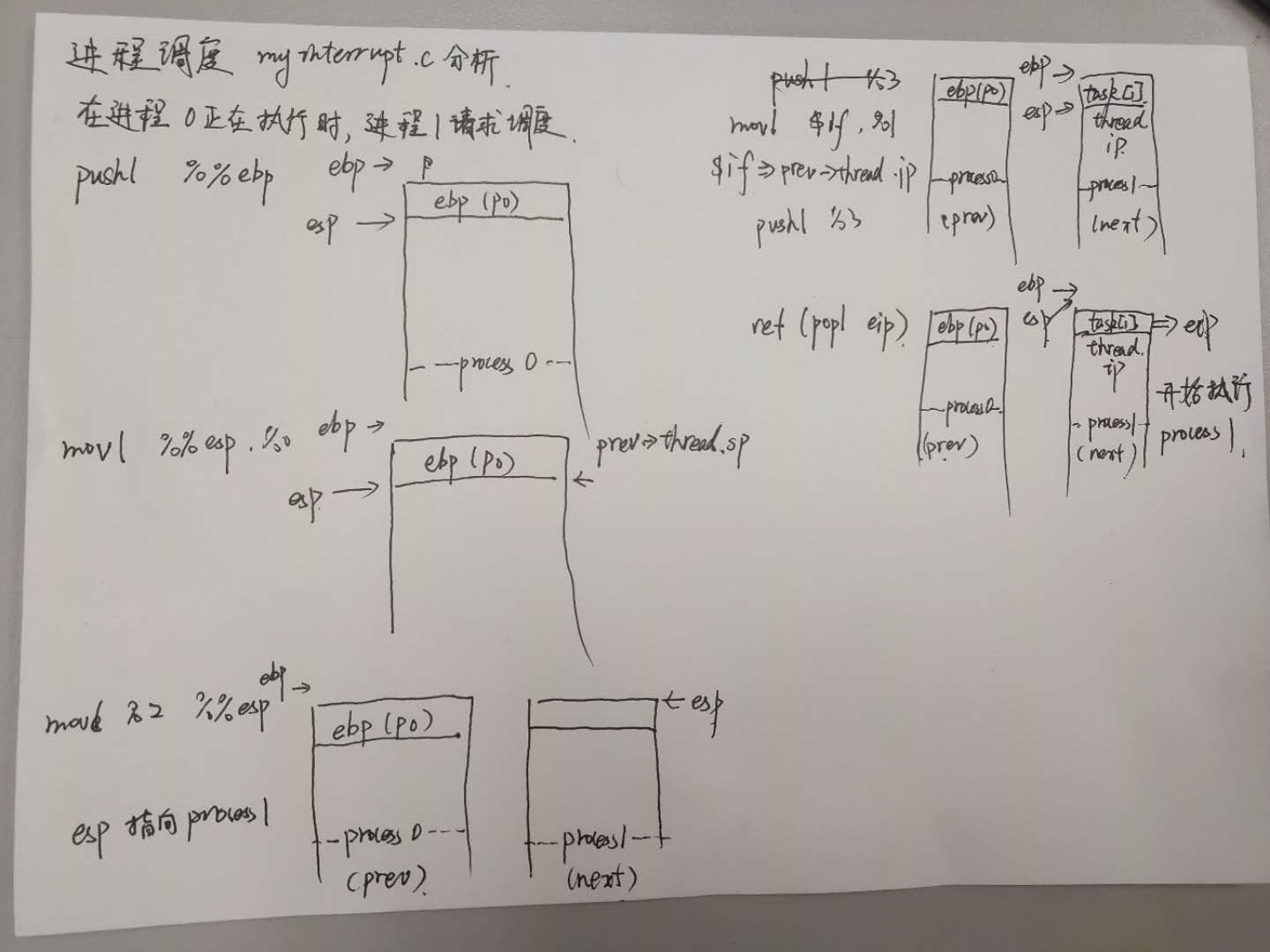
"pushl %%ebp" /* 保存当前ebp */
"movl %%esp,%0" /* 保存当前esp */
"movl %2,%%esp" /* 重新记录要跳转进程的esp ,%2为 next->thread.sp*/
"movl %2,%%ebp" /* 重新记录要跳转进程的ebp,%2为 next->thread.sp */
"movl $1f,%1" /* 保存当前eip ,%1为prev->thread.ip,%1f就是指标号1:的代码在内存中存储的地址*/
"pushl %3"
"ret" /* 重新记录要跳转进程的eip,%3为 next->thread.ip */
: "=m" (prev->thread.sp),"=m" (prev->thread.ip)
: "m" (next->thread.sp),"m" (next->thread.ip)
遇到的问题
这周遇到的问题很低级
- Markdown的书写问题,列表中无序列表的嵌套总是会格式不对。
- 想要自己设计代码实现mykernel时间片轮转多道程序,心有不逮,行有不逮
- 这周的学习时间分配不均匀,因为一些客观存在的外部因素和一些主观上的内在因素干扰,学习计划没有很好实施。之后要严格执行自己的计划表。
- 时间片轮转调度是操作系统调度算法的基础组成部分,在此基础上复习其他调度算法,尝试实现一下,参考博客:[浅析Linux内核调度]![]
